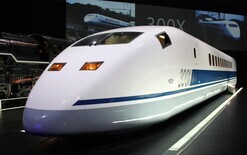Tesla Semi truck: what we know so far
Tesla has unveiled its all-electric semi-truck, aptly named the ‘Tesla Semi’. The Semi is the latest step in Tesla CEO Elon Musk’s mission to accelerate the shift to sustainable transportation. It boasts a significant charge capacity, and its aesthetically distinct look will help the Semi stand out from the other class 8 freight vehicles on the road. “From day one, having a Tesla semi will beat a diesel truck on economics,” Musk stated on Friday in California. “It’s got better drag coefficient than a supercar.” Without a trailer, the Tesla Semi can achieve 0-100 kmh in five seconds, compared to 15 seconds in a comparable diesel truck. It does 0-100 kmh in 20 seconds with a full 80,000-pound load, a task that takes a diesel truck about a minute, Tesla says. Most notably the Tesla Semi requires no shifting or clutching for smooth acceleration and deceleration, and its regenerative braking recovers 98% of kinetic energy to the battery, giving it a basically infinite brake life. Overall, the Semi is more responsive, covers more miles than a diesel truck in the same amount of time, and more safely integrates with passenger car traffic. Musk also claimed that if a driver were to have a medical emergency, the truck would come to an automatic stop, and would call for help if the driver wasn’t responsive. The truck’s low centre of gravity makes for good handling and roll-over prevention, and its technology makes jack-knifing impossible, Musk said. The semi has automated-driving features including lane-keeping and automatic braking, and has four independent motors, he said. “Even if you have only two of the motors active, it’ll still beat a diesel truck,” he said. On one charge Tesla’s truck will be able to travel 800 kilometres at 96 kmh, with Musk adding that 80 per cent of trucking routes in the US are shorter than 400 kilometres. A statement from an advocacy group for diesel vehicle and engine manufacturers was also issued at the same time as the announcement. “Diesel is the most energy efficient internal combustion engine,” said Allen Schaeffer, the group’s executive director. “It has achieved dominance as the technology of choice in the trucking industry over many decades and challenges from many other fuel types. Still, today, diesel offers a unique combination of unmatched features: proven fuel efficiency, economical operation, power, reliability, durability, availability, easy access to fuelling and service facilities, and now near-zero emissions performance.” The launch also comes as the company faces financial and production issues. The most recent quarterly earnings report revealed a NZ$895.9 million loss and three-month delay for the Model 3 sedan. Tesla is also venturing into an uncertain market. Demand for electric trucks is expected to grow over the next decade as the US, Europe and China tighten their emission regulations. So, it makes sense that Tesla is going after a market that contains traditional and mostly diesel-powered trucks, which is estimated to reach US$34 billion by 2020. However, many analysts expect the demand for electric trucks to centre around smaller, medium-duty haulers like rubbish trucks and delivery vans. These trucks can be charged overnight and due to their limited range, they require fewer expensive batteries. Long-haul semi-trucks can be expected to go greater distances which can be a challenging variable. There's little charging infrastructure on global highways and charging even a medium sized truck would likely require a two-hour stop, cutting into companies' efficiency and profits, said Brian Irwin, managing director of the North American industrial group for the consulting firm Accenture. However Tesla maintains that owners can expect to gain US$200,000 or more in savings over a million miles based on fuel costs alone due to the low and stable nature of electricity prices. These prices can be significantly less for commercial and industrial users, falling to almost nothing when combined with local solar generation and storage. The new electric Semi truck will be released into the market in around two year’s time.





